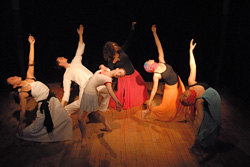The Sahel: a Crack in the Heart
This performance highlights social
tensions as a result of desertification in the Sahel region of Africa.
Re-inspired
This piece quotes the speeches of
Martin Luther King, Jr. and President Barack Obama to depict the political scene
we have grown from and the progressive future we have the potential to create.
Ripples in Motion
This site-specific performance
highlights our personal impact on the planet while revealing the fragile beauty
of nature and humanityís relationship to it.
Stories and Snapshots
This performance highlights the
ongoing problems of indifference, explores how it is manifested, challenges its
causes, and finds new ways to inspire action and solutions.
Archive Information:
The Sahel A Crack In The Heart
Modern Dance Performance
Directed By Christina Coleman
50 Minute Work
 "The Sahel is a line. But it is also a crack in the heart-a tightrope, a
brink a ledge. See how its people walk: straight-backed and on paths of red
dust, placing one foot carefully before the other, as if balanced upon a knife
edge. The Sahel is a bulletís trajectory. It is the tracks of rain that fall but
never touch the sand...It is a call for your blood, and for me a desert road
without end."
"The Sahel is a line. But it is also a crack in the heart-a tightrope, a
brink a ledge. See how its people walk: straight-backed and on paths of red
dust, placing one foot carefully before the other, as if balanced upon a knife
edge. The Sahel is a bulletís trajectory. It is the tracks of rain that fall but
never touch the sand...It is a call for your blood, and for me a desert road
without end."
- Paul Salopek
- Humanity transcends culture, religion, race and nationality. While set in The
Sahel, the music, the movement, the characters and the costumes signify the
universality of the human condition. It could happen anywhere.
 - The performance we are creating
is on the desertification of the Sahel region, a vast area of Africa. This
region, just south of the Sahara Desert, occurs at the fault line of Arabic and
African cultures. The problem of encroaching desert (which, it must be
acknowledged, is not universally accepted), continues to disrupt the lives of
millions of innocent people. In this artistic endeavor we can use the powerful,
expressive potential of dance to portray these current life-and-death issues.
- The performance we are creating
is on the desertification of the Sahel region, a vast area of Africa. This
region, just south of the Sahara Desert, occurs at the fault line of Arabic and
African cultures. The problem of encroaching desert (which, it must be
acknowledged, is not universally accepted), continues to disrupt the lives of
millions of innocent people. In this artistic endeavor we can use the powerful,
expressive potential of dance to portray these current life-and-death issues.
- We are not only addressing the
issue of desertification, but we are also showing the many underlying factors
that are at work here as well. We are doing character studies, depicting the
role of the West, looking at the many cultures who live in the area, identifying
the religions in the Sahel, recognizing the issues with property rights,
illuminating the catastrophic results of desertification such as starvation,
social conflict, and death and finally identifying the overall toll that
desertification is taking on those who are left alive.
 "The Sahel is a line. But it is also a crack in the heart-a tightrope, a
brink a ledge. See how its people walk: straight-backed and on paths of red
dust, placing one foot carefully before the other, as if balanced upon a knife
edge. The Sahel is a bulletís trajectory. It is the tracks of rain that fall but
never touch the sand...It is a call for your blood, and for me a desert road
without end."
"The Sahel is a line. But it is also a crack in the heart-a tightrope, a
brink a ledge. See how its people walk: straight-backed and on paths of red
dust, placing one foot carefully before the other, as if balanced upon a knife
edge. The Sahel is a bulletís trajectory. It is the tracks of rain that fall but
never touch the sand...It is a call for your blood, and for me a desert road
without end." - The performance we are creating
is on the desertification of the Sahel region, a vast area of Africa. This
region, just south of the Sahara Desert, occurs at the fault line of Arabic and
African cultures. The problem of encroaching desert (which, it must be
acknowledged, is not universally accepted), continues to disrupt the lives of
millions of innocent people. In this artistic endeavor we can use the powerful,
expressive potential of dance to portray these current life-and-death issues.
- The performance we are creating
is on the desertification of the Sahel region, a vast area of Africa. This
region, just south of the Sahara Desert, occurs at the fault line of Arabic and
African cultures. The problem of encroaching desert (which, it must be
acknowledged, is not universally accepted), continues to disrupt the lives of
millions of innocent people. In this artistic endeavor we can use the powerful,
expressive potential of dance to portray these current life-and-death issues.